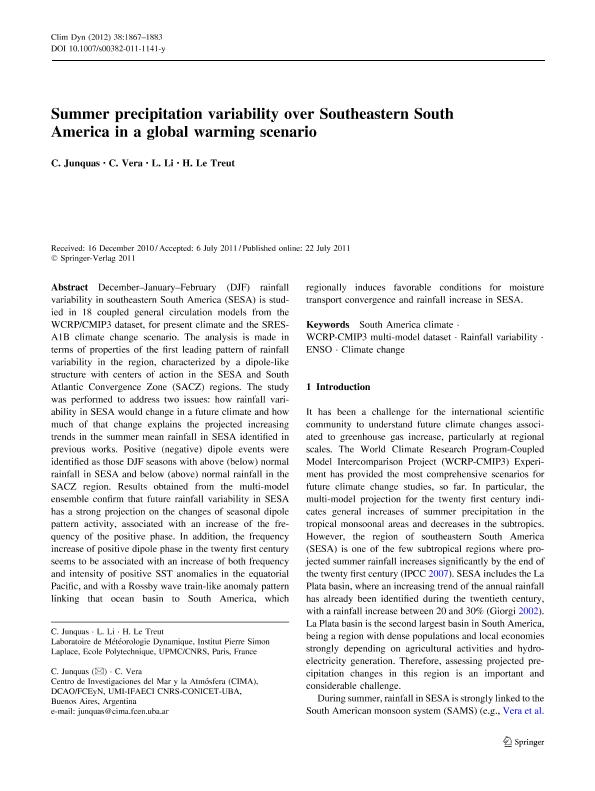Mostrar el registro sencillo del ítem
dc.contributor.author
Junquas, C.
dc.contributor.author
Vera, Carolina Susana

dc.contributor.author
Li, L.
dc.contributor.author
Le Treut, H.
dc.date.available
2017-05-31T21:35:40Z
dc.date.issued
2012-05
dc.identifier.citation
Junquas, C.; Vera, Carolina Susana; Li, L.; Le Treut, H.; Summer precipitation variability over Southeastern South America in a global warming scenario; Springer; Climate Dynamics; 38; 9; 5-2012; 1867-1883
dc.identifier.issn
0930-7575
dc.identifier.uri
http://hdl.handle.net/11336/17229
dc.description.abstract
December–January–February (DJF) rainfall variability in southeastern South America (SESA) is studied in 18 coupled general circulation models from the WCRP/CMIP3 dataset, for present climate and the SRESA1B climate change scenario. The analysis is made in terms of properties of the first leading pattern of rainfall variability in the region, characterized by a dipole-like structure with centers of action in the SESA and South Atlantic Convergence Zone (SACZ) regions. The study was performed to address two issues: how rainfall variability in SESA would change in a future climate and how much of that change explains the projected increasing trends in the summer mean rainfall in SESA identified in previous works. Positive (negative) dipole events were identified as those DJF seasons with above (below) normal rainfall in SESA and below (above) normal rainfall in the SACZ region. Results obtained from the multi-model ensemble confirm that future rainfall variability in SESA has a strong projection on the changes of seasonal dipole pattern activity, associated with an increase of the frequency of the positive phase. In addition, the frequency increase of positive dipole phase in the twenty first century seems to be associated with an increase of both frequency and intensity of positive SST anomalies in the equatorial Pacific, and with a Rossby wave train-like anomaly pattern linking that ocean basin to South America, which regionally induces favorable conditions for moisture transport convergence and rainfall increase in SESA.
dc.format
application/pdf
dc.language.iso
eng
dc.publisher
Springer

dc.rights
info:eu-repo/semantics/openAccess
dc.rights.uri
https://creativecommons.org/licenses/by-nc-sa/2.5/ar/
dc.subject
South America Climate
dc.subject
Wcrp-Cmip3 Multi-Model Dataset
dc.subject
Rainfall Variability
dc.subject
Enso
dc.subject.classification
Meteorología y Ciencias Atmosféricas

dc.subject.classification
Ciencias de la Tierra y relacionadas con el Medio Ambiente

dc.subject.classification
CIENCIAS NATURALES Y EXACTAS

dc.title
Summer precipitation variability over Southeastern South America in a global warming scenario
dc.type
info:eu-repo/semantics/article
dc.type
info:ar-repo/semantics/artículo
dc.type
info:eu-repo/semantics/publishedVersion
dc.date.updated
2017-05-31T19:43:16Z
dc.identifier.eissn
1432-0894
dc.journal.volume
38
dc.journal.number
9
dc.journal.pagination
1867-1883
dc.journal.pais
Alemania

dc.journal.ciudad
Berlin
dc.description.fil
Fil: Junquas, C.. Universite Pierre et Marie Curie; Francia. Centre National de la Recherche Scientifique; Francia
dc.description.fil
Fil: Vera, Carolina Susana. Consejo Nacional de Investigaciones Científicas y Técnicas. Oficina de Coordinación Administrativa Ciudad Universitaria. Centro de Investigaciones del Mar y la Atmosfera. Universidad de Buenos Aires. Facultad de Ciencias Exactas y Naturales. Centro de Investigaciones del Mar y la Atmosfera; Argentina
dc.description.fil
Fil: Li, L.. Universite Pierre et Marie Curie; Francia. Centre National de la Recherche Scientifique; Francia
dc.description.fil
Fil: Le Treut, H.. Universite Pierre et Marie Curie; Francia. Centre National de la Recherche Scientifique; Francia
dc.journal.title
Climate Dynamics

dc.relation.alternativeid
info:eu-repo/semantics/altIdentifier/doi/http://dx.doi.org/10.1007/s00382-011-1141-y
dc.relation.alternativeid
info:eu-repo/semantics/altIdentifier/url/https://link.springer.com/article/10.1007%2Fs00382-011-1141-y
Archivos asociados
